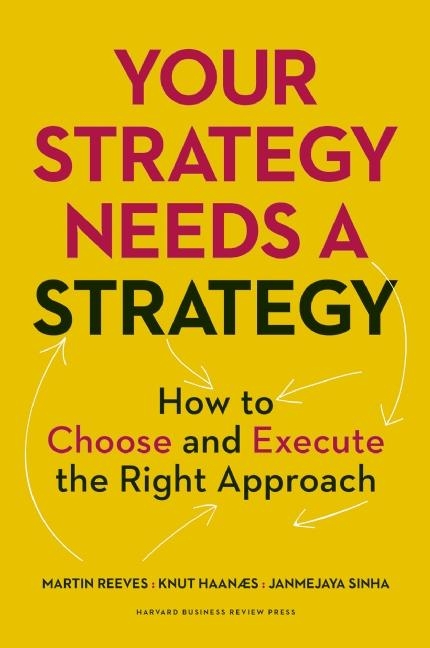Your Strategy Needs a Strategy: How to Choose and Execute the Right Approach
June 18, 2015
Martin Reeves, Knut Haanaes, and Janmejaya Sinha of Boston Consulting Group provide a lesson on why our strategies need a strategy, and a guidebook to do it.

Your Strategy Needs a Strategy: How to Choose and Execute the Right Approach by Martin Reeves, Knut Haanaes, and Janmejaya Sinha, Harvard Business Review Press, Hardcover, 267 pages, 9781625275868
One of the things that makes reading and writing about business books enjoyable is the constant variation of the vehicle. While there is a natural cap to the intrinsic subject matter—leadership, management, innovation, etc.—the way that material is communicated continues to fascinate. Some business book authors create picture books to help convey their message; some craft an intricate and colorful narrative about an industry and sometimes imbed their own beliefs within the story; some authors write about more esoteric sociological subjects that can help us inform how we work and the workplaces we inhabit, and some authors are simply great writers who can make any topic an engrossing read. Then there are the books that stray less far from academe and present readers with a substantial guidebook, and a structured lesson, to apply much like a professor might present in an MBA class. And, unsurprisingly, those kinds of business books often come from graduate school presses like this one—Your Strategy Needs a Strategy: How to Choose and Execute the Right Approach—which comes to us from the Harvard Business Review Press.
Reeves, Haanaes, and Sinha have one goal in this book, and they execute it very well, making this book a must-read for anyone who has been given the steering wheel of a company and is looking to set the right course. The authors lay out the problem: strategy is essentially planning, and traditionally, a company has enjoyed the ability to lay out a year-to-year, long-term plan for success. But, technology and global influences and volatility in the markets no longer allows a company to look far into the future and estimate the heights to climb and the obstacles to come. Things simply change too quickly, so there is no one-size-fits-all approach to strategic planning. But first, leaders need to understand what they are dealing with.
Business environments differ along three easily discernible dimensions: predictability (can you forecast it?), malleability (can you, either alone or in collaboration with others, shape it?), and harshness (can you survive it?)
The answers to those questions allow leaders to then plot their company on a grid of five environments that the authors call The Strategy Palette that range from the Classical (“I can predict it, but I can’t change it”) to the Adaptive (“I can’t predict it, and I can’t change it”) to the Visionary (“I can predict it and I can change it”) to the Shaping (“I can’t predict it, but I can change it”) and finally, to the Renewal, for companies that might be on their last legs (“My resources are severely constrained”).
Each environment corresponds to a distinct archetypal approach to strategy, or color in the strategy palette, as follows:
Classical: Be big.
Adaptive: Be fast.
Visionary: Be first.
Shaping: Be the orchestrator.
Renewal: Be viable.
No doubt you, as I did, have already started to think about your own company in relationship to these environments and archetypes. I tend to think of 800-CEO-READ’s place in the big publishing industry as adaptive. “Firms employ an adaptive approach when the business environment is neither predictable nor malleable.” But the authors make sure to warn us that we don’t always see our industry or our company with clear eyes because, well, we are human, so we like “to believe that we can predict and control our environment.” And even if we choose the right strategic approach, we don’t always apply it correctly. Ultimately, a company may use more than one approach for different areas of the business, leading to a “multidimensional approach as ambidexterity.” Companies such as Apple and Corning are exemplars of this more complex approach.
All told, Your Strategy Needs a Strategy is straightforward, evidence-based, and applicable to a wide-range of companies and leadership challenges.
Throughout the book, the authors present ways to avoid the typical mistakes in both choosing and executing one of these approaches, and also include a chapter on how leaders can become “the animators of a dynamic combination of multiple approaches to strategy” which includes eight leadership roles to help guide the change. Three appendices include a self-assessment quiz, a reading list, and a simulation model. They also include a brief chapter on how these options can also be applied to anyone’s personal strategy.
If you aren’t sure where your company is going (or even where you yourself are headed), or your board or stakeholders require a long-range plan, Your Strategy Needs a Strategy offers a clear method for mapping the ever-changing topography of business.


